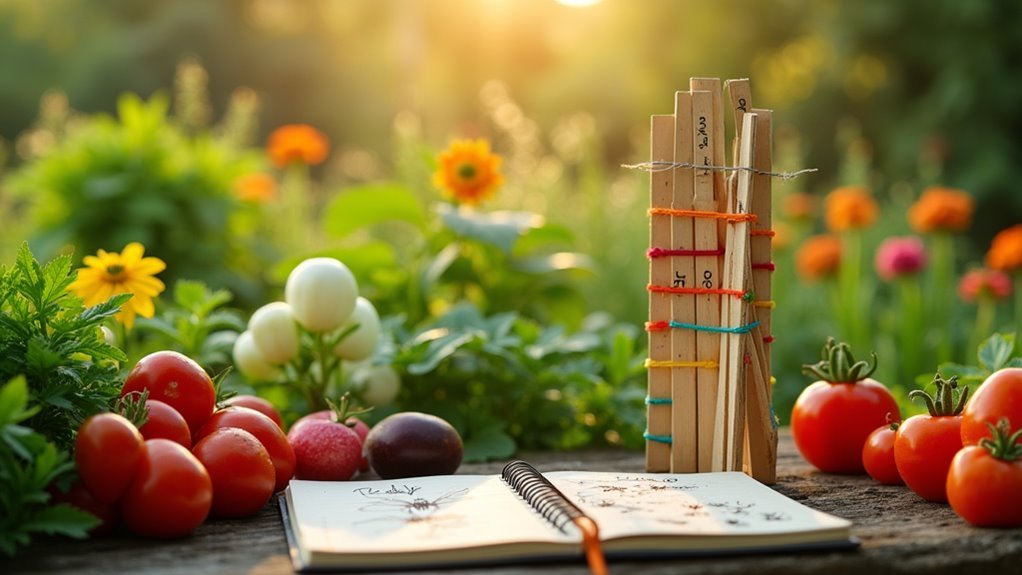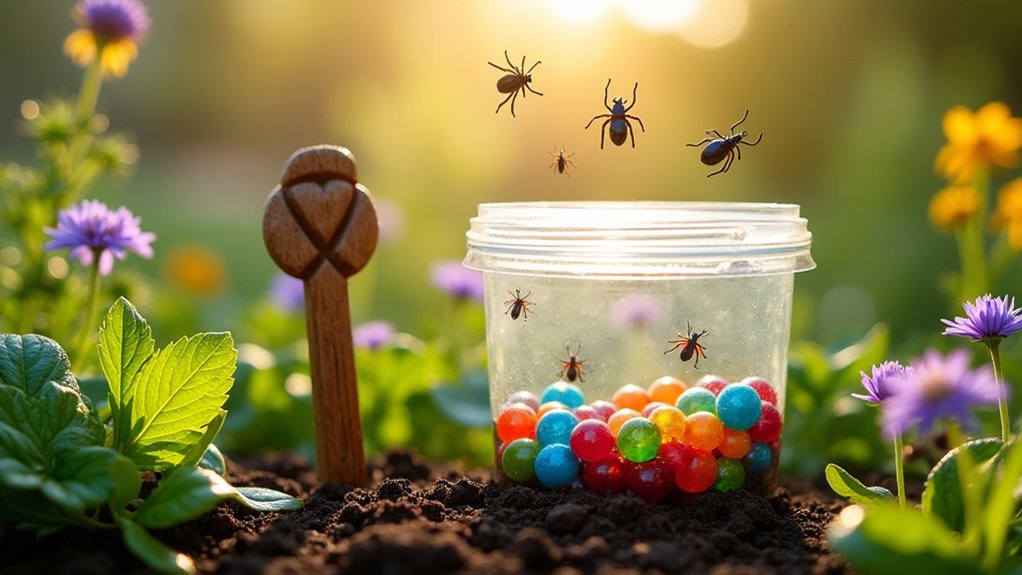You can create an effective garden pest tracker using just a notebook or free smartphone app in under 30 minutes. Start by logging essential details for each pest sighting: date, location, pest type, and affected plants. Include photos when possible and schedule weekly garden inspections for consistency. Digital apps offer GPS tracking and automatic reports, while paper logs provide reliable backup records. This simple system will reveal seasonal patterns and help you shift from reactive to proactive pest management strategies.
Setting Up Your Basic Pest Tracking System
Vigilance forms the backbone of effective garden pest management, and establishing a systematic tracking approach will transform your random observations into actionable data.
Start by choosing a dedicated notebook or digital app specifically for logging pest encounters. You’ll track essential details: date, location, and pest type observed. Create a simple chart categorizing pests and diseases by type—insects, fungal issues, or weeds—making identification patterns easier to spot.
Include a visual component by photographing affected plants or actual pests. These images become invaluable references for future identification.
Schedule weekly garden inspections to maintain consistent monitoring. Research treatment options for common problems in your area, incorporating Integrated Pest Management strategies into your system. This foundation supports effective garden planning and quick response protocols.
Essential Information to Record for Each Pest Sighting
When you encounter a pest in your garden, capturing specific details transforms casual observations into powerful management tools. Your pest sighting records should include the exact date and time to reveal activity patterns.
Mark the precise location where you spotted the pest to identify problem areas. Document the pest type for accurate pest identification – even rough descriptions help.
Note which plant species affected by recording what the pest was targeting since many pests prefer specific crops. Don’t forget to track environmental conditions like temperature and humidity during each sighting.
Keeping track of these details consistently leads to healthier gardens by helping you predict when and where problems will emerge, making prevention easier than treatment.
Digital Vs Physical Tracking Methods
When tracking garden pests, you’ll need to choose between digital apps and traditional paper logs, each offering distinct advantages for your monitoring needs.
App-based systems like EDDMapS IPM provide real-time GPS tracking, photo uploads, and automatic reminders that streamline your pest management workflow.
Paper logs offer reliable backup records that don’t depend on technology, allowing you to jot down personalized observations without worrying about battery life or connectivity issues.
App-Based Tracking Benefits
Although traditional pen-and-paper tracking methods have served gardeners for generations, app-based pest monitoring offers significant advantages that can transform how you manage garden threats. You’ll receive real-time notifications about pest activity, allowing immediate responses to infestations. With integrated databases containing over 90 plant identification references, you can quickly identify garden pests and diseases using your smartphone camera.
| Feature | App-Based | Physical Methods |
|---|---|---|
| Updates | Real-time notifications | Manual logging required |
| Analytics | Automatic trend reports | Limited analysis capability |
| Resources | Community-driven support | Individual knowledge only |
GPS mapping capabilities let you track pest spread patterns across your garden, while automated analytics help optimize your pest management strategies. Community-driven platforms connect you with fellow gardeners, expanding your knowledge beyond what traditional methods offer.
Paper Log Advantages
Despite the digital revolution transforming garden management, paper logs retain distinct advantages that make them invaluable for dedicated gardeners.
You’ll find that paper logs offer unmatched accessibility – there’s no need for charged devices or internet connections when you spot pest sightings in your garden. You can track patterns and activities without digital distractions, allowing focused observation of your plants.
Paper logs become a customized system reflecting your unique gardening style. You can add sketches of damage patterns, use color codes for different pest types, or attach photos.
This creates a creative outlet while building practical pest management strategies. Your physical log serves as a permanent historical record, helping you identify seasonal trends and evaluate treatment effectiveness over multiple growing seasons.
Using Mobile Apps to Enhance Your Pest Records
You can revolutionize your pest tracking with mobile apps that use AI to instantly identify bugs and diseases from photos you take in your garden.
These apps include GPS features that automatically tag your location, creating precise maps of where specific pest issues occur across different areas of your property.
Digital record management systems within these apps organize all your pest data chronologically, making it easy to spot patterns and track treatment effectiveness over time.
AI-Powered Pest Identification
When pests strike your garden, AI-powered mobile apps like Plantix and Agrio can transform how you identify and track these unwelcome visitors. These sophisticated tools use image recognition technology to identify pests and diseases by simply uploading photos of affected plants.
You’ll receive instant diagnoses for over 90 plant problems, making gardening more efficient and effective.
These apps enhance your pest management approach through:
- Real-time expert advice that reduces reliance on harmful pesticides while promoting natural pest control methods
- Environmental monitoring tools that track weather conditions and vegetation health indices
- Collaborative databases where you can share findings with other gardeners, improving identification accuracy over time
You’ll make informed decisions using tailored treatment strategies that support sustainable Integrated Pest Management practices.
GPS Tracking Features
Beyond simple photo identification, modern pest tracking apps leverage GPS technology to transform scattered observations into thorough data maps.
When you’re monitoring your garden, GPS-enabled apps like EDDMapS IPM and Farm Scout Pro let you geotag pest sightings in real-time, creating precise location records that reveal infestation patterns.
These features help gardeners plan targeted interventions by showing exactly where problems occur. You’ll receive hyper-local weather updates through apps like Plantix, since weather conditions directly influence pest activity.
GPS pest tracking also enables community collaboration—you can share sightings with nearby gardeners, building collective knowledge about local threats.
Most importantly, you’ll create visual maps showing how your control measures perform over time, making future garden management decisions more informed and effective.
Digital Record Management
While traditional paper logs can easily become damaged or lost, digital record management through mobile apps revolutionizes how you’ll organize and preserve your pest monitoring data.
These user friendly platforms streamline your pest tracking efforts by automatically organizing information with timestamps and location data.
Mobile apps enhance your documentation capabilities through:
- Photo Integration – Upload pest images for quick identification and future reference
- Treatment Tracking – Record application methods and monitor effectiveness over time
- Data Analysis – Generate reports showing pest patterns and seasonal trends
You’ll build extensive databases that inform better pest management decisions.
Identifying Patterns and Seasonal Trends in Pest Activity
As you track pest activity throughout multiple growing seasons, you’ll begin to notice distinct patterns that reveal when specific pests are most likely to strike your garden.
Your recorded pest sightings will show clear seasonal trends – aphids and spider mites consistently appear as temperatures warm, while other pests emerge after specific weather patterns like heavy rainfall or high humidity periods.
Temperature increases trigger aphid and spider mite emergence, while rainfall and humidity patterns signal the arrival of other garden pests.
Document environmental factors alongside each pest observation to identify patterns between weather conditions and infestations.
A simple chart or spreadsheet helps visualize these trends, showing peak seasons for particular pests.
This historical data transforms your pest management approach from reactive to proactive.
You’ll time interventions when pests are most vulnerable, reducing chemical dependency while maximizing control effectiveness through strategic Integrated Pest Management practices.
Taking Action Based on Your Tracking Data

Once you’ve gathered sufficient tracking data, transform those observations into decisive pest management actions that protect your garden before problems escalate.
Your pest tracking information becomes the foundation for smart, targeted interventions that enhance effectiveness while minimizing environmental impact.
Here’s how to leverage your data for ideal pest management:
- Set action thresholds – Establish specific pest population levels that trigger preventative action, ensuring you intervene only when necessary rather than applying blanket treatments.
- Coordinate with weather forecasts – Compare your tracking data with upcoming weather patterns to predict pest surges and implement timely interventions before infestations peak.
- Apply targeted treatments – Use your data to pinpoint problem areas and specific pest types, enabling precise applications that support eco-friendly gardening practices while reducing chemical dependency.
Frequently Asked Questions
Is Seedtime Really Free?
Yes, Seedtime’s really free during its private BETA phase. You’ll get unlimited planting schedules, task lists, journal entries, plus access to 70+ crops and 3,000+ varieties without needing a credit card.
What Is the Best Free Sun Tracking App for Gardening?
You’ll find SunCalc App is the best free sun tracking option for gardening. It’s available on Apple and Android devices, providing visual sun path representations and tracking sunlight hours throughout different seasons.
How Do You Make a Pest Free Garden?
You’ll create a pest-free garden by implementing IPM techniques, encouraging beneficial insects through companion planting, maintaining healthy soil, using physical barriers like row covers, and monitoring regularly with pest tracking tools.
Is There an App That Can Design Your Garden?
Yes, you can use several garden design apps like Garden Planner Online, Better Homes and Gardens Plan-A-Garden, or Smart Gardener. They’ll help you create layouts with drag-and-drop features and 3D visualization tools.
In Summary
You’ll discover that consistent pest tracking transforms your gardening approach from reactive to proactive. Your documented patterns and seasonal trends won’t just identify problems—they’ll predict them. Whether you’ve chosen digital apps or traditional notebooks, you’re now equipped to make informed decisions about treatments and prevention. Don’t underestimate the power of this simple system; it’ll revolutionize how you protect your garden and maximize your harvest yields.





Leave a Reply